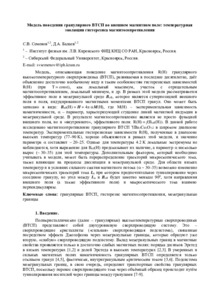Показать сокращенную информацию
Model of the Behavior of a Granular HTS in an External Magnetic Field: Temperature Evolution of the Magnetoresistance Hysteresis
| Автор | Semenov, S. V. | |
| Автор | Balaev, D. A. | |
| Дата внесения | 2021-08-13T09:33:50Z | |
| Дата, когда ресурс стал доступен | 2021-08-13T09:33:50Z | |
| Дата публикации | 2020-07 | |
| Библиографическое описание | Semenov, S. V. Model of the Behavior of a Granular HTS in an External Magnetic Field: Temperature Evolution of the Magnetoresistance Hysteresis [Текст] / S. V. Semenov, D. A. Balaev // Physics of the Solid State. — 2020. — Т. 62 (№ 7). — С. 1136-1144 | |
| ISSN | 10637834 | |
| URI (для ссылок/цитирований) | https://link.springer.com/article/10.1134/S1063783420070239 | |
| URI (для ссылок/цитирований) | https://elib.sfu-kras.ru/handle/2311/142996 | |
| Описание | Текст статьи не публикуется в открытом доступе в соответствии с политикой журнала. | |
| Аннотация | A model for describing the magnetoresistance behavior in a granular high-temperature superconductor (HTS) that has been developed in the last decade explains a fairly extraordinary form of the hystereticR(H) dependences atT= const and their hysteretic features, including the local maximum, the negative magnetoresistance region, and the local minimum. In the framework of this model, the effective fieldBeffin the intergrain medium has been considered, which represents a superposition of the external field and the field induced by the magnetic moments of HTS grains. This field can be written in the formBeff(H) =H+ 4 pi alpha M(H), whereM(H) is the experimental field dependence of the magnetization and alpha is the parameter of crowding of the magnetic induction lines in the intergrain medium. Therefore, the magnetoresistance is a function of not simply an external field, but also the "internal" effective fieldR(H) =f(Beff(H)). The magnetoresistance of the granular YBa2Cu3O7 - delta HTS has been investigated in a wide temperature range. The experimental hystereticR(H) dependences obtained in the high -temperature range (77-90 K) are well explained using the developed model and the parameter alpha is 20-25. However, at a temperature of 4.2 K, no local extrema are observed, although the expression forBeff(H) predicts them and the parameter alpha somewhat increases (similar to 30-35) at this temperature. An additional factor that must be taken into account in this model can be the redistribution of the microscopic current trajectories, which also affects the dissipation in the intergrain medium. At low temperatures under the strong magnetic flux compression (alpha similar to 30-35), the microscopic trajectories of the currentI(m)can change and tunneling through the neighboring grain is preferred, but the angle betweenI(m)andB(eff)will be noticeably smaller than 90 degrees, although the external (and effective) field direction is perpendicular to the macroscopic current direction. | |
| Тема | granular HTS | |
| Тема | magnetoresistance hysteresis | |
| Тема | grain boundaries | |
| Название | Model of the Behavior of a Granular HTS in an External Magnetic Field: Temperature Evolution of the Magnetoresistance Hysteresis | |
| Тип | Journal Article | |
| Тип | Journal Article Preprint | |
| Страницы | 1136-1144 | |
| Дата обновления | 2021-08-13T09:33:50Z | |
| DOI | 10.1134/S1063783420070239 | |
| Институт | Институт инженерной физики и радиоэлектроники | |
| Подразделение | Кафедра общей физики | |
| Журнал | Physics of the Solid State | |
| Квартиль журнала в Scopus | Q3 | |
| Квартиль журнала в Web of Science | Q4 |

